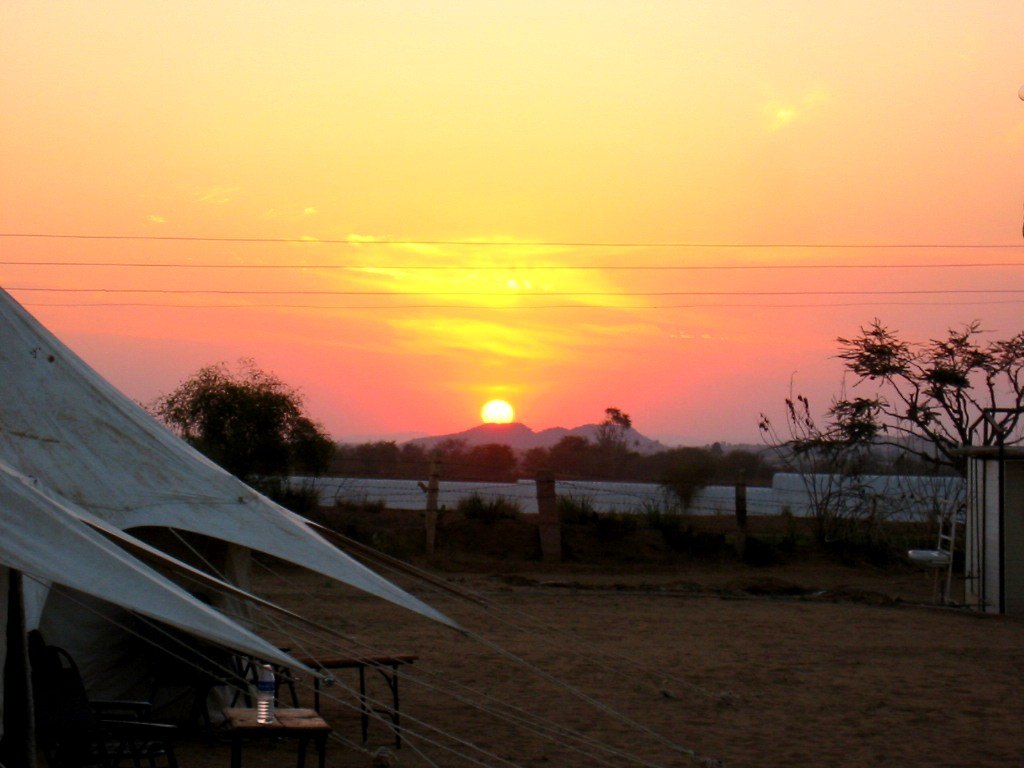
Desert Safari
In addition to its status
as one of India's holiest towns, Pushkar is also home to the
largest camel fair in Asia, held every spring. On our second
day in Pushkar, we traveled into the nearby desert on an
overnight trip. Meeting the camel drivers at the edge of
town, we were each dispatched a camel and driver and began
our journey. If you have never been on a camel, it can be an
intimidating experience for several reasons. First, they
make loud braying noises, and spit rather indiscriminately,
as several of us discovered over the course of the next
several hours. Also, mounting the camel is a bit tricky.
Riders climb on the camel when it is on all fours. When it
rises, it rises back legs first, which puts the rider at a
very steep angle, facing down. Saddles are a rather loose
strap of blankets held together by ropes; they have only a
wiggly saddle horn and rope loops for stirrups (invariably
set for someone with legs a foot shorter than our own).
After a  moment of terror, we were off,
our steeds guided by chain-smoking 12-year old boys who
delighted in showing us how fast the animals could go, a
truly bone-jarring (but fun) experience. It soon became
apparent that little guidance was really needed, as the boys
would hop off for a
moment of terror, we were off,
our steeds guided by chain-smoking 12-year old boys who
delighted in showing us how fast the animals could go, a
truly bone-jarring (but fun) experience. It soon became
apparent that little guidance was really needed, as the boys
would hop off for a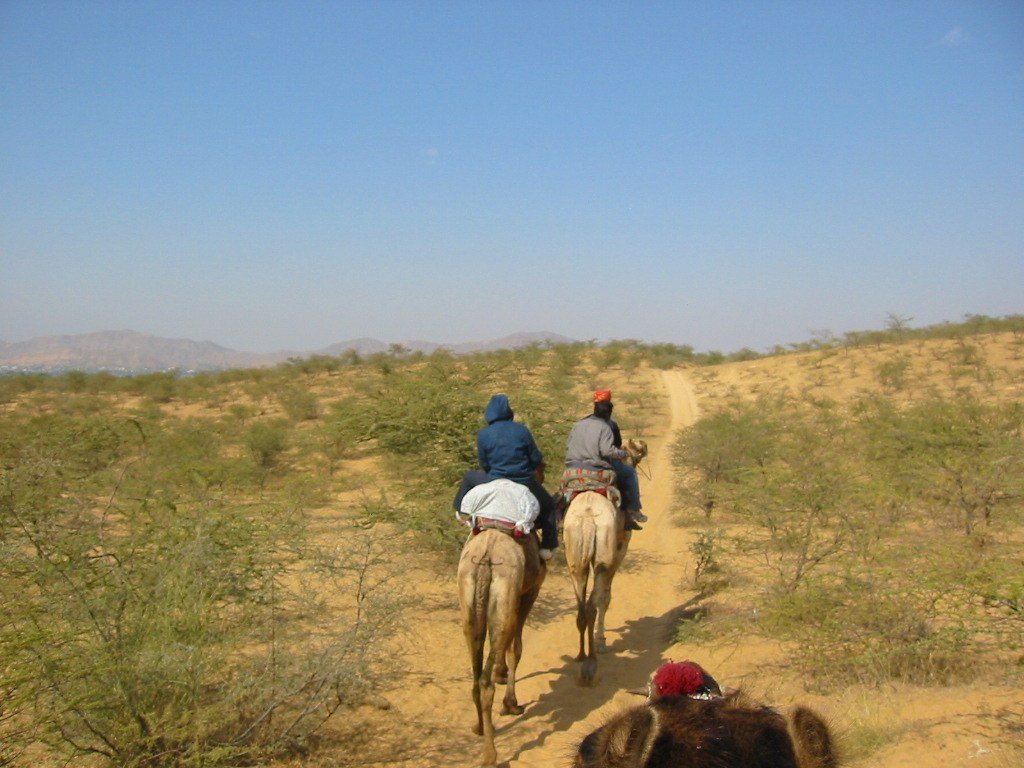 smoke and the camels continued to amble toward
a destination that they probably knew by heart. The photo
above left
shows us meeting up with the caravan at the outskirts of
Pushkar, while the photo at the upper right shows us leaving
the town via the path that led out into the desert. As we
left town, we passed numerous small farms (an example is
shown in the photo at lower left) before reaching the open
desert (lower right photo). Of course,
when one mentions desert, most of us think of the rolling
sand dunes of North Africa. As you can see from the
photo the Rajasthani desert is quite different, a
sandy and barren plain with scant vegetation, much like the
American West. The YouTube video below give some idea of
what this experience was like.
smoke and the camels continued to amble toward
a destination that they probably knew by heart. The photo
above left
shows us meeting up with the caravan at the outskirts of
Pushkar, while the photo at the upper right shows us leaving
the town via the path that led out into the desert. As we
left town, we passed numerous small farms (an example is
shown in the photo at lower left) before reaching the open
desert (lower right photo). Of course,
when one mentions desert, most of us think of the rolling
sand dunes of North Africa. As you can see from the
photo the Rajasthani desert is quite different, a
sandy and barren plain with scant vegetation, much like the
American West. The YouTube video below give some idea of
what this experience was like.
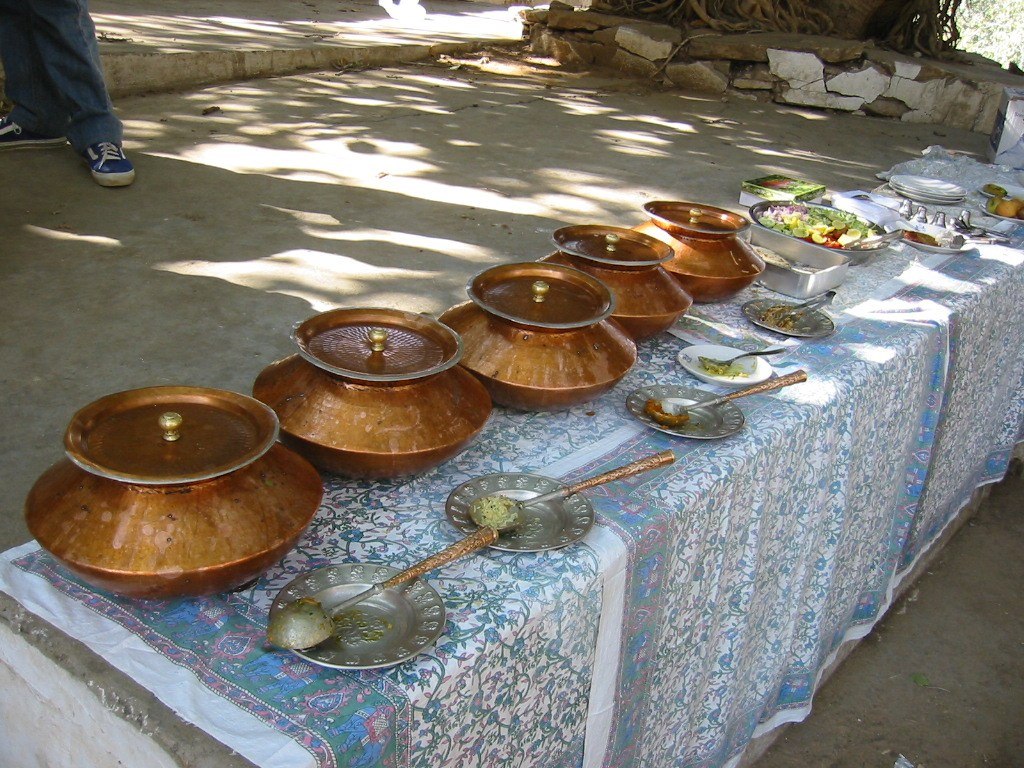
 We did not
proceed directly to our camp, but rather trekked for several
hours out into the desert, breaking for lunch at a
Rajasthani version of an oasis, a grove of trees on a hill
overlooking the plain. As we were still in the Pushkar
region, the meal was entirely vegetarian and, best of all,
it was entirely catered. Caravans of jeeps brought out the
food which was served in large copper kettles (photo
to the left). One of the most succulent treats was a
sugar-flavored desert bread, a bit reminiscent of similar
treats found in the Middle East. After mounting our camels,
we turned back toward Pushkar, passing through several small
villages enroute to the camp. Along the way we were greeted
by scores of children (photo to the right). It must be said
that the third and fourth hours of camel riding produced
saddle sores in all of us.
We did not
proceed directly to our camp, but rather trekked for several
hours out into the desert, breaking for lunch at a
Rajasthani version of an oasis, a grove of trees on a hill
overlooking the plain. As we were still in the Pushkar
region, the meal was entirely vegetarian and, best of all,
it was entirely catered. Caravans of jeeps brought out the
food which was served in large copper kettles (photo
to the left). One of the most succulent treats was a
sugar-flavored desert bread, a bit reminiscent of similar
treats found in the Middle East. After mounting our camels,
we turned back toward Pushkar, passing through several small
villages enroute to the camp. Along the way we were greeted
by scores of children (photo to the right). It must be said
that the third and fourth hours of camel riding produced
saddle sores in all of us.
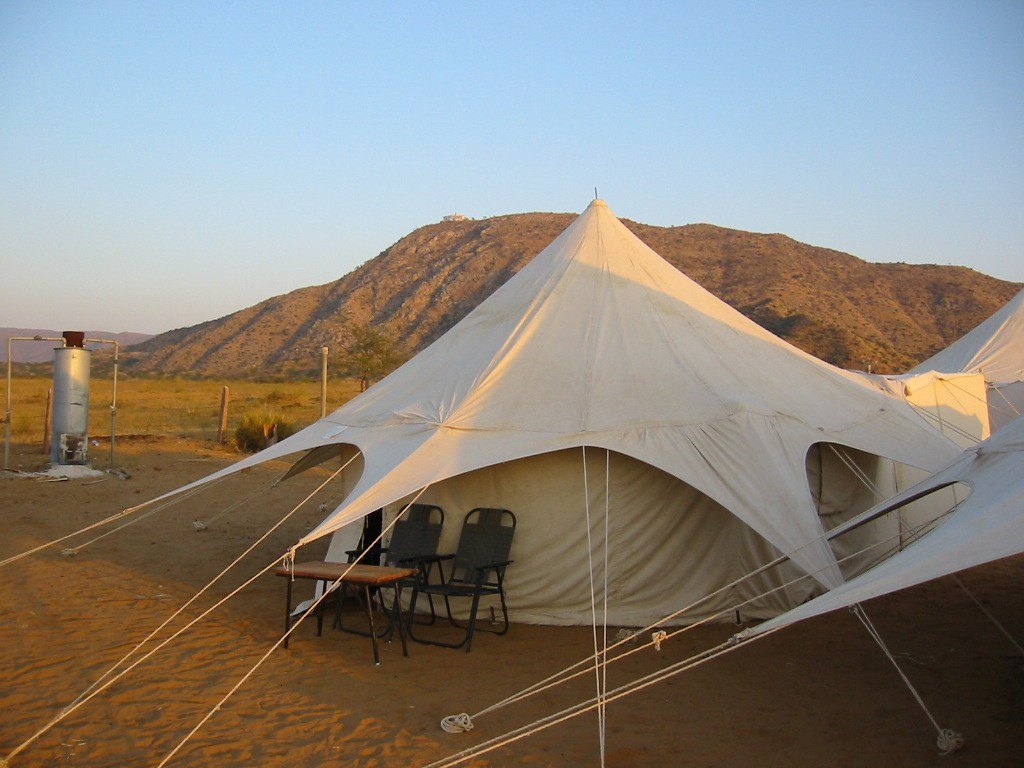
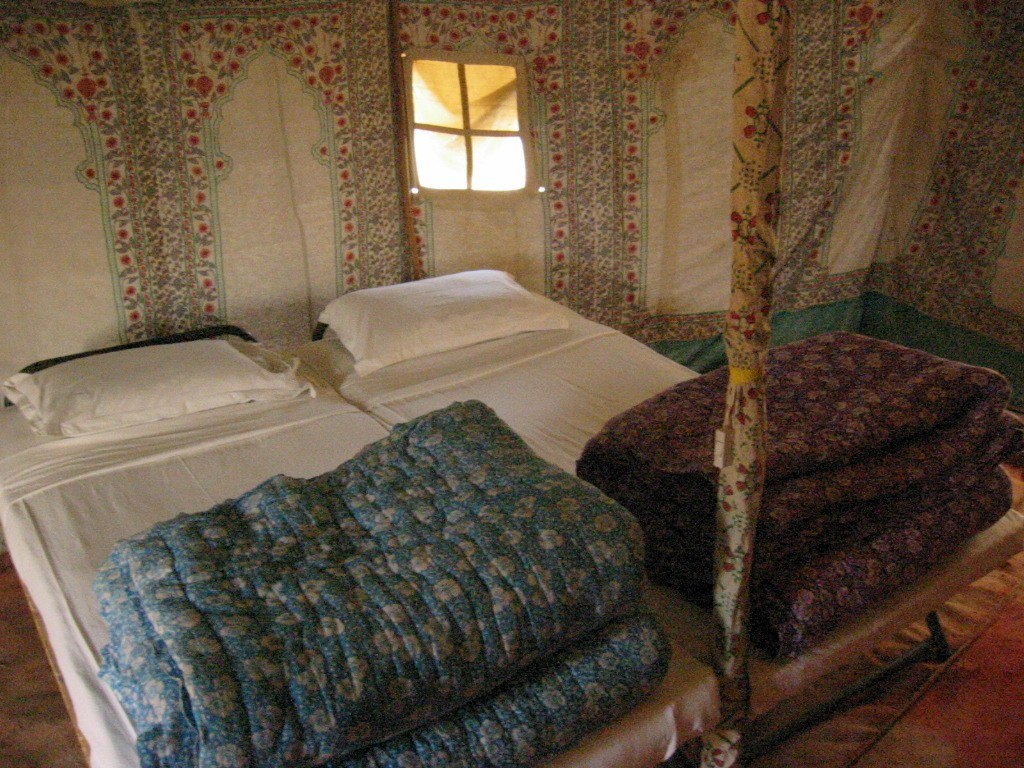 Our
destination camp was owned by Prince Mahendra, a member of
the Pushkar royal family, and our gracious host while
staying in this region. The camp was quite large (we
occupied only a portion of the total area), and it is
designed to house the many traders and visitors to the
annual Pushkar camel fair, the largest in Asia. While the
tents looked basic from the outside (photo to the left), as
the photos attest, this was no ordinary camp, but a series
of tents equipped with modern amenities. The interior of the
tent was carpeted and had real beds, replete with mattress
and springs. The interior walls of the tent were decorated,
and it boasted a chair and table as well. Connected to the
main tent was a side tent that contained a complete
bathroom! The bathroom is built on a permanent concrete
slab, which is then covered by an awning.
Our
destination camp was owned by Prince Mahendra, a member of
the Pushkar royal family, and our gracious host while
staying in this region. The camp was quite large (we
occupied only a portion of the total area), and it is
designed to house the many traders and visitors to the
annual Pushkar camel fair, the largest in Asia. While the
tents looked basic from the outside (photo to the left), as
the photos attest, this was no ordinary camp, but a series
of tents equipped with modern amenities. The interior of the
tent was carpeted and had real beds, replete with mattress
and springs. The interior walls of the tent were decorated,
and it boasted a chair and table as well. Connected to the
main tent was a side tent that contained a complete
bathroom! The bathroom is built on a permanent concrete
slab, which is then covered by an awning. 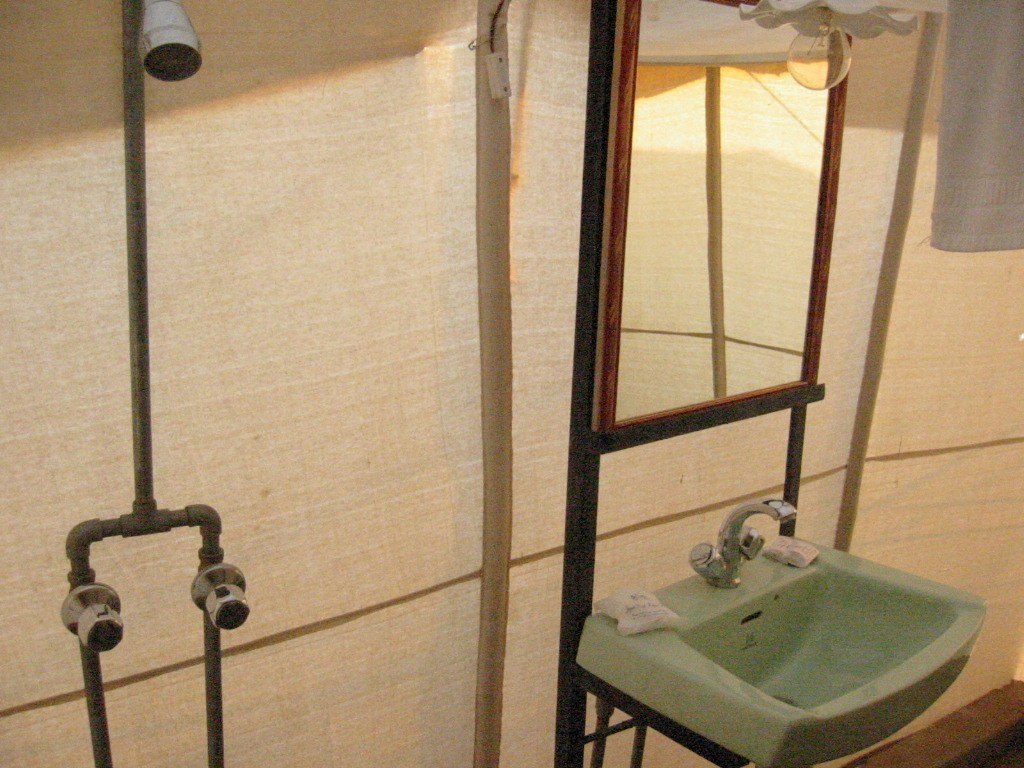 So,
each tent had a toilet, hot and cold running water, and a
shower. The Boy Scouts was never like this. The photo at the
bottom left shows the bathroom area. After four hours in the
desert
So,
each tent had a toilet, hot and cold running water, and a
shower. The Boy Scouts was never like this. The photo at the
bottom left shows the bathroom area. After four hours in the
desert 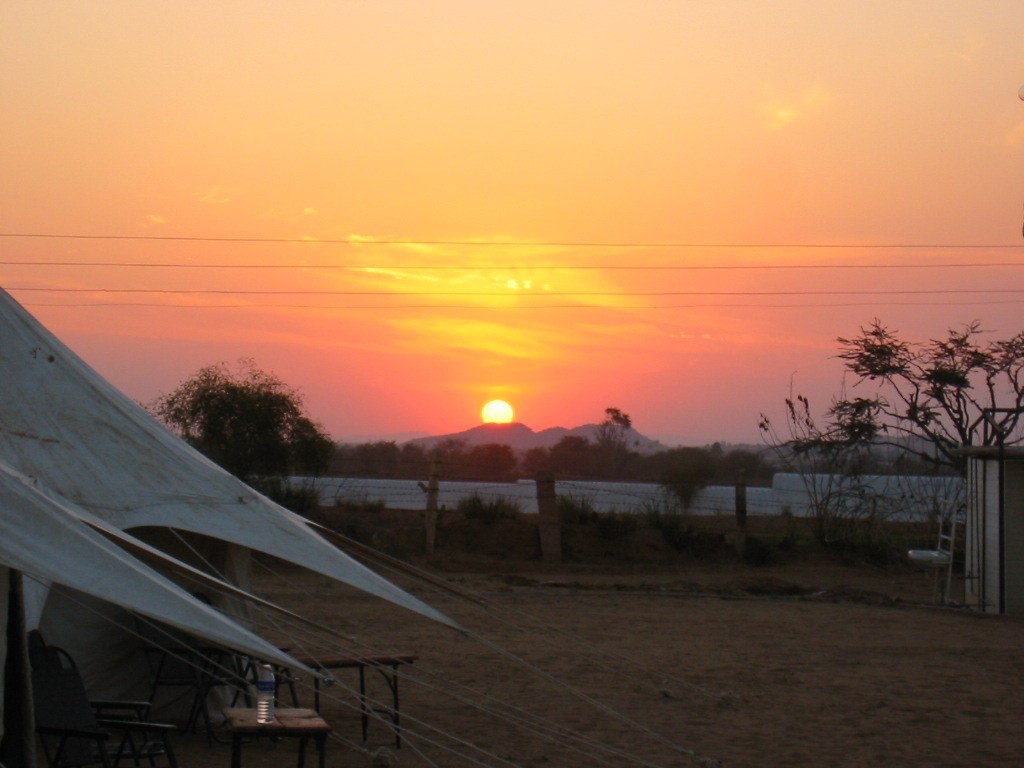 dust and heat,
it was truly a treat to have such a nice place to relax and
freshen up. The photo to the right shows the camp at dusk,
as we turned our attention to food and entertainment.
dust and heat,
it was truly a treat to have such a nice place to relax and
freshen up. The photo to the right shows the camp at dusk,
as we turned our attention to food and entertainment.

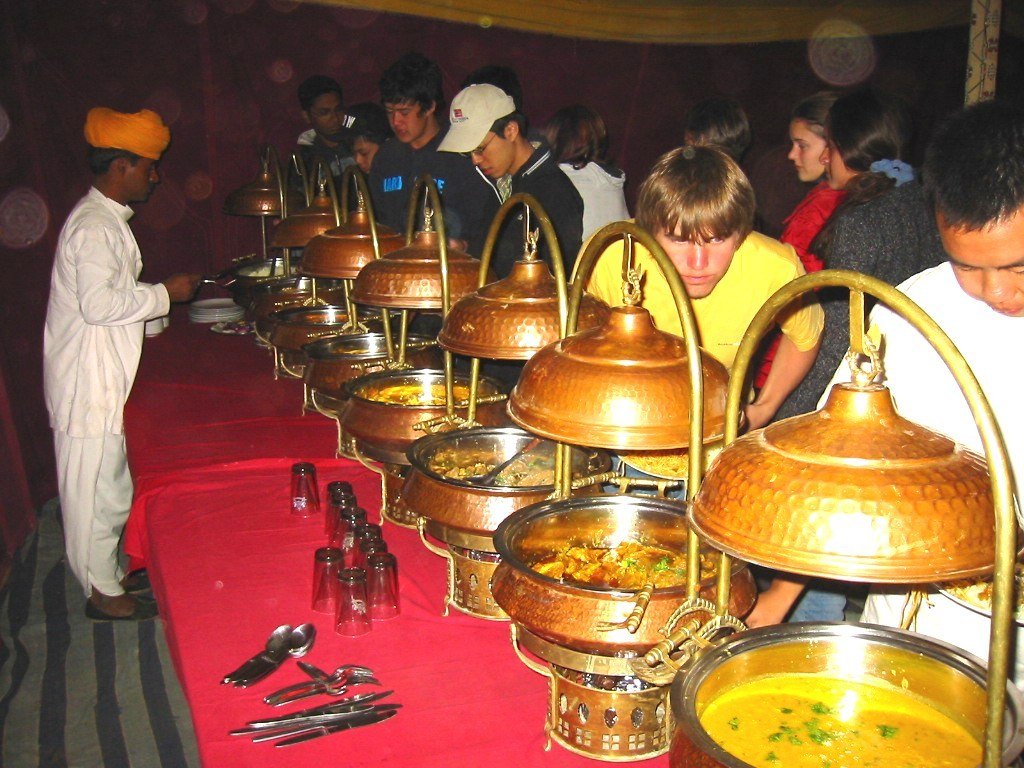 Prince
Mahendra arranged for us to have some local entertainment,
in the form of three musicians and two dancers from a local
village. They demonstrated traditional Rajasthani dances for
the group and enticed some of the more talented (and
coordinated) members to join in. One of the things that
struck us immediately about the performers were the
diminutive size of the dancers. Although adult women, even
the most petite members of our group towered over them. The
music and dancing was beautiful and the sound wafted out
into the desert night. Following the music and dance, we
settled into to a typical Rajasthani dinner, again served in
the large copper kettles. Our exploits during the day (not
to mention dancing) had given us quite an appetite.
Prince
Mahendra arranged for us to have some local entertainment,
in the form of three musicians and two dancers from a local
village. They demonstrated traditional Rajasthani dances for
the group and enticed some of the more talented (and
coordinated) members to join in. One of the things that
struck us immediately about the performers were the
diminutive size of the dancers. Although adult women, even
the most petite members of our group towered over them. The
music and dancing was beautiful and the sound wafted out
into the desert night. Following the music and dance, we
settled into to a typical Rajasthani dinner, again served in
the large copper kettles. Our exploits during the day (not
to mention dancing) had given us quite an appetite.
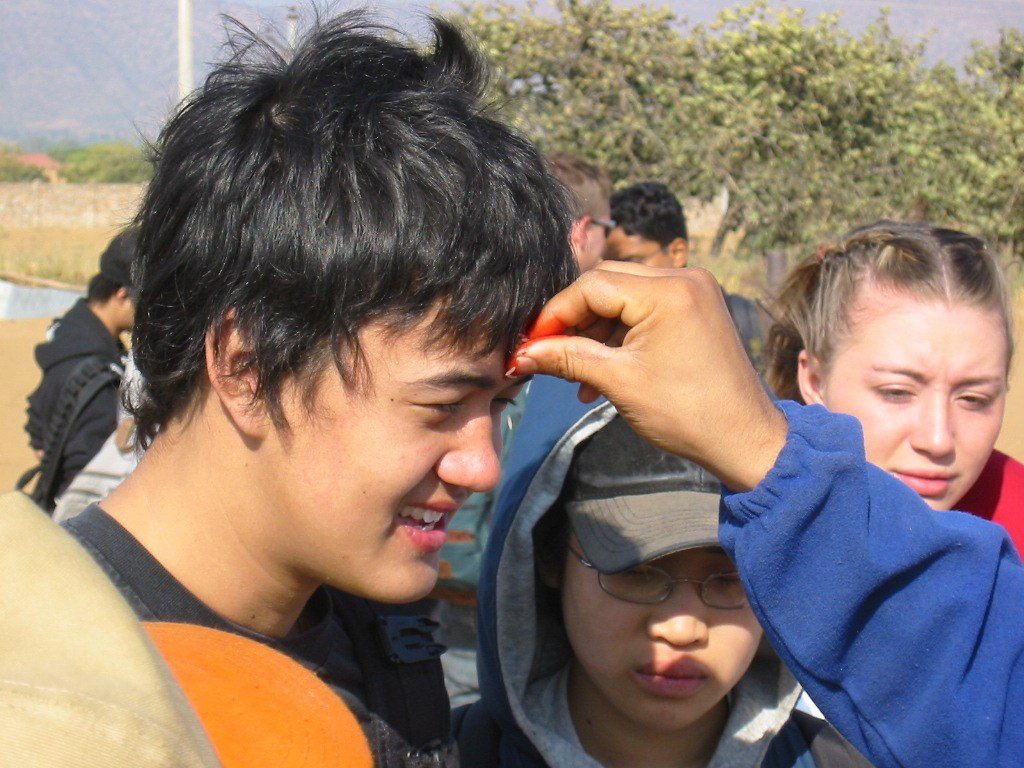
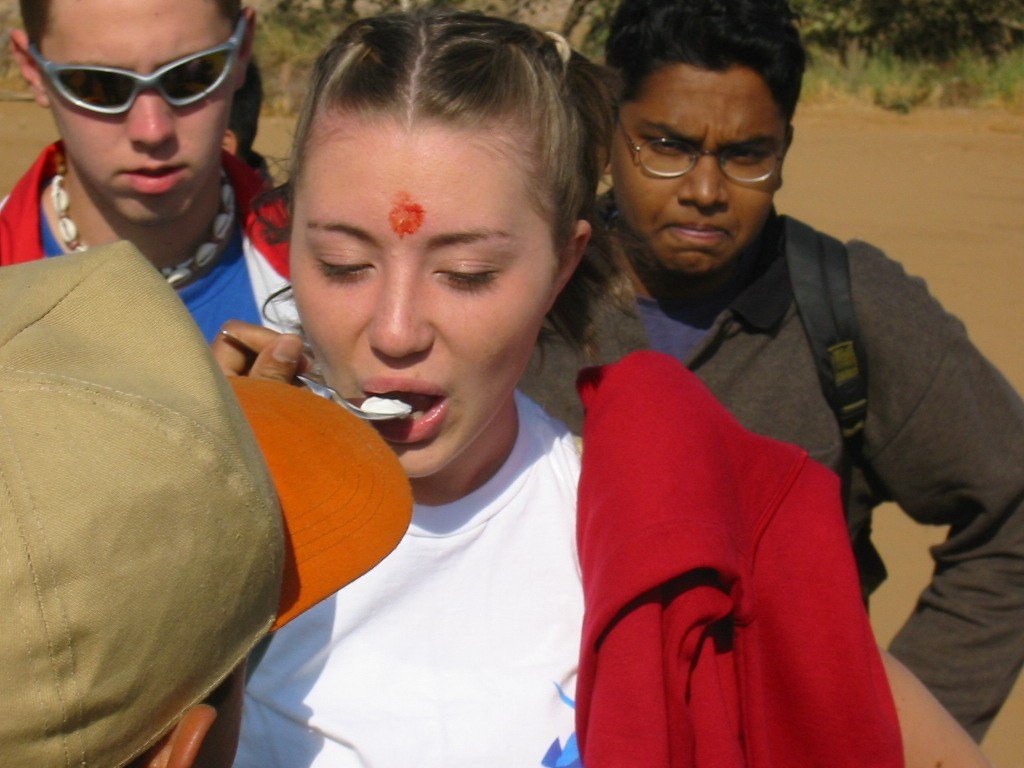 Next
morning we awakened, had breakfast, and prepared to embark
for Ajmer to board the train for Delhi. Prince Mahendra bade
us farewell from the camp with a traditional Rajasthani
ceremony. The ceremony involved placing a tika (the red mark
on the forehead) using red paste (symbolizing health),
grains of rice, (symbolizing prosperity), and a sweet
yoghurt (an enticement to return). The photo at the top left
shows Chris receiving the red paste and rice, while the
photo to the right shows Meghan tasting the sweet yoghurt.
The photo at the bottom right shows the platter of
ingredients. After a fond farewell, we were off to Pushkar
and then Ajmer by bus, and then boarded the overnight
express to Delhi.
Next
morning we awakened, had breakfast, and prepared to embark
for Ajmer to board the train for Delhi. Prince Mahendra bade
us farewell from the camp with a traditional Rajasthani
ceremony. The ceremony involved placing a tika (the red mark
on the forehead) using red paste (symbolizing health),
grains of rice, (symbolizing prosperity), and a sweet
yoghurt (an enticement to return). The photo at the top left
shows Chris receiving the red paste and rice, while the
photo to the right shows Meghan tasting the sweet yoghurt.
The photo at the bottom right shows the platter of
ingredients. After a fond farewell, we were off to Pushkar
and then Ajmer by bus, and then boarded the overnight
express to Delhi.